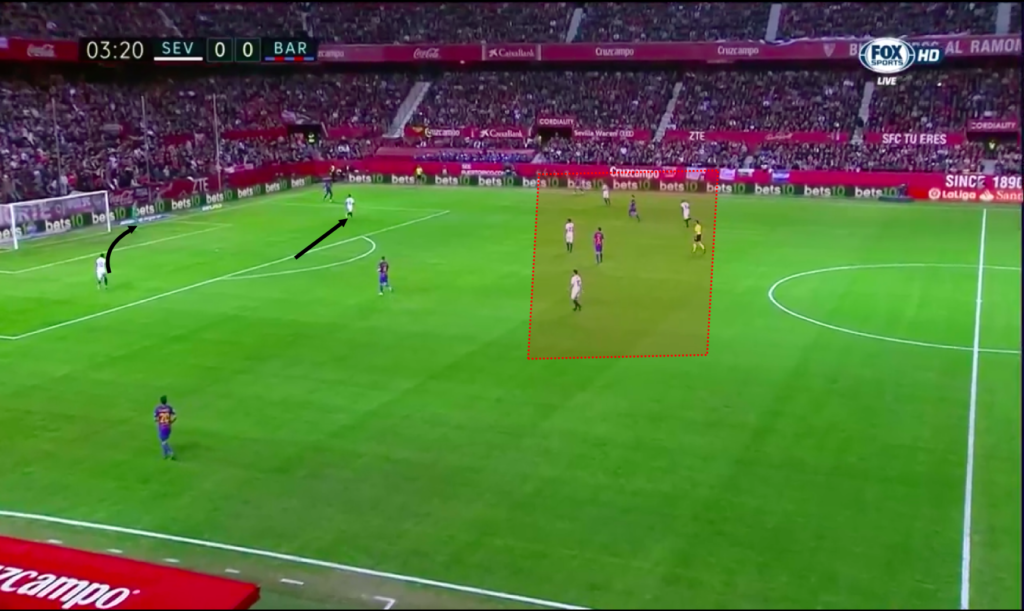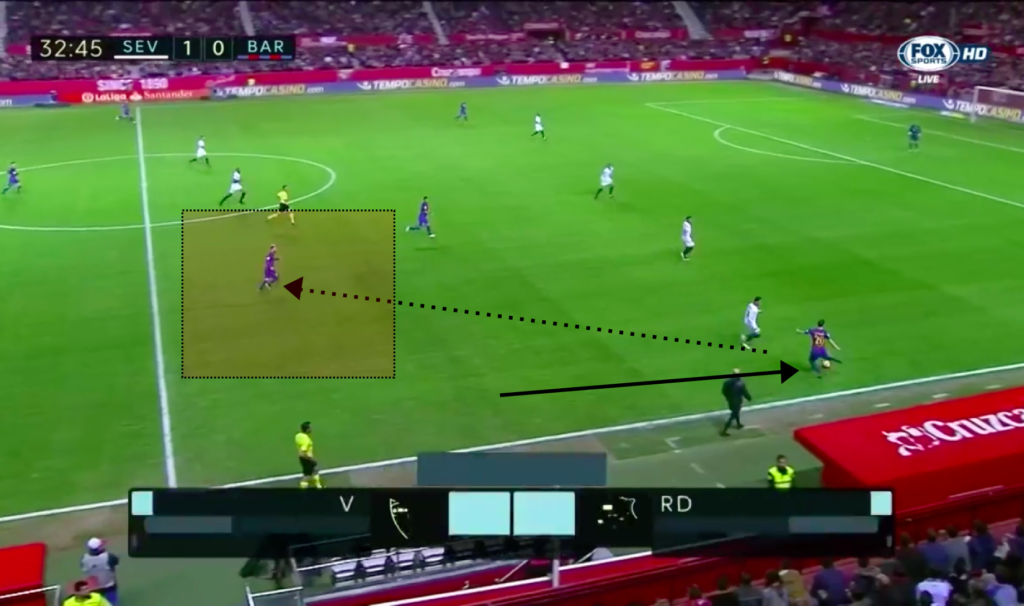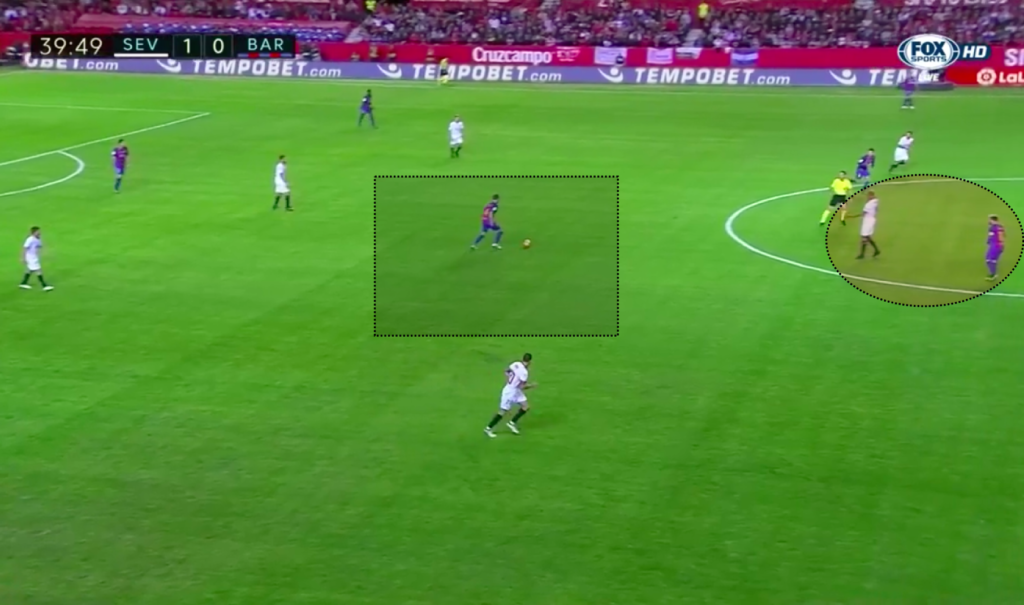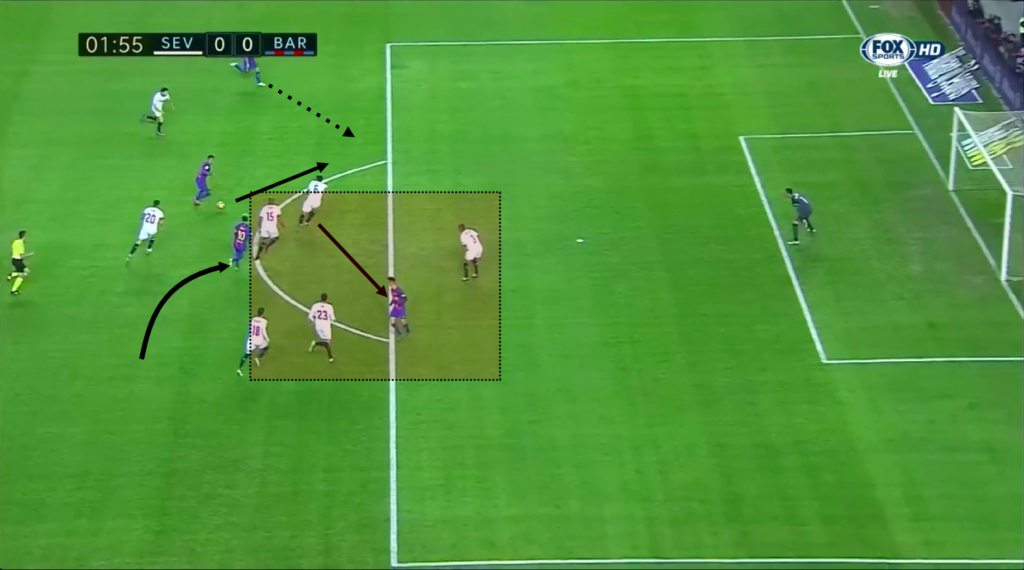Transition focused Barca beat Sampaoli’s directional pressing
Fresh from their midweek defeat to Manchester City, Enrique’s Barcelona travelled to the Sanchez Pizjuan on Sunday night for an eagerly anticipated clash with Sevilla. An away win would see the Catalan side close the gap on leaders Real Madrid to 2 points, however they were struggling in the absence of Iniesta and Pique in particular. As for the hosts life under Sampaoli was bliss and victory would leave them 3 points off the pace and dreaming of a title challenge.
Sevilla’s high block and pressing
When preparing to face Barcelona there are several incredibly important factors that teams must attempt to negate; not least a certain Lionel Messi. The latest attempt to control the extra-terrestrial force came in the shape of Sampaoli’s high-flying Sevilla.
Sevilla’s attempts to reduce Messi’s influence began right from Barcelona’s goal kicks whereby they held a typically high block which was specifically designed to force the game away from the diminutive Argentine. In these situations Vitolo would move forwards from his left flank spot to join Vietto in the front line. With Vitolo positioned on the left edge of the box for immediate access to press Mascherano and Vietto positioned in the centre edge of the box Umtiti was the logical first passing choice for ter Stegen. By forcing the play to Barcelona’s left Sevilla would theoretically be able to reduce Messi’s involvement in the game.
In order to effectively prevent Messi’s involvement however Sevilla knew they would have to prevent Barcelona from switching the play which could mean they would succeed only in increasing Messi’s space to operate. After the initial pass from ter Stegen to Umtiti, Vitolo would move higher and occupy a position whereby he could both discourage passes back to ter Stegen and prevent the centre back switch to Mascherano. Without either of these options to recycle the ball Umiti was forced to carry the ball down the left side.
Sevilla however were still intent on regaining possession and Vietto would shift across to force Umiti into hasty decisions. Furthermore they retained a typically tight man-oriented strategy with each Barcelona player on the near side being followed. With the exit routes to the far side covered and the ball-near players tightly marked, Sevilla were able to force a number of turnovers with their pressing. Another aspect of this was the superior physicality Sevilla held in several duels with the likes of N’zonzi and Mariano marking Denis Suarez and Neymar respectively. This superior physicality gave them an advantage in the event of longer passes from Umtiti.
This was crucial in destabilising Barcelona and it led to the continuation of a recent trend namely a wing-oriented build-up. Whilst Sevilla’s pressing was generally well co-ordinated and intense to deny the Catalans easy access to the centre they were clearly missing the extraordinary needle ability of Iniesta. However the wing focus seems to be partially designed with the wide movements of the interiors acting as a tool to overload the flanks and combine to advance.
Barca’s build-up methods
As they sought to beat Sevilla’s pressing and build their passing rhythm, Enrique’s men used a number of different methods with varying success rates.
One of these methods came in the instances where Busquets dropped into the first line creating a temporary 3 chain, despite the movement taking place in the centre of the field the effect was felt most on the wings. With the temporary back 3 the side backs were free to move occupy wider positions, in turn Barcelona’s full-backs could move advance up their respective flanks. This movement allowed Barcelona to generate free men in the half spaces, namely Messi and Neymar which were predictably advantageous situations.
This situation largely occurred after switches whereby Sevilla’s front 2 naturally focused on the ball-near centre back and Busquets leaving the ball-far centre back free. When Barca switched to the ball-far centre back it they had sizeable time frames to act in before Sevilla’s forwards shifted across. Thus the ball-near winger would be in a situation where he needed to press the ball carrier but was wary of the full-back whom he was marking. By advancing aggressively the full-back moved out of the wingers’ responsibility and into the area of Sevilla’s full-back. In these situations Messi or Neymar became free to receive the ball in the half space.
Another way Enrique’s side attempted to beat Sevilla’s press was to move Messi into the centre of the field, swapping with Suarez. This was potentially in response to how effective Sevilla initially were in limiting Messi’s involvement. By moving Messi into the centre either wing would now be the same distance away from him making Sevilla’s directional pressing less of a factor in the game.
This did not have an immediate effect, particularly from goal kicks where any lofted passes towards Messi could be won by the home side rather easily. However towards the end of the first half as Barcelona gained territory there were a number of occasions where his presence made Sevilla’s midfielders hesitant to move out of position to mark their opponents. With this Barcelona were able to move forwards with simple passes into midfield to the likes of Rakitic.
Transitions create chances
Despite these sides being two of the strongest Spanish teams with the ball, both sides encountered some difficulties in their possession game. Barcelona largely struggled to resist and bypass the intense and strongly co-ordinated Sevilla press. Sevilla meanwhile suffered the effects of a poorly connected positional structure which struggled to connect from deep areas to the high presence behind Barcelona’s midfield line. This was due to poor presence behind Barcelona’s forward line which meant they were often forced into direct passes from deep or advancing through the wings.
With these issues on both sides it was no surprise that many of the best chances came from counter attacking situations. There were a number of interesting aspects in the way both sides approached these counter attacking situations.
Barcelona’s counter attacks had two major interesting features, the typically diagonal nature and the balancing movements that facilitated this diagonal orientation. With the main counter attacking instigators, Messi and Neymar, playing on the opposite side to their preferred foot their teammates focus on creating the best conditions for them to cut inside with balancing movements.
The balancing movements performed by Luis and Denis Suarez are impressive not only through the speed and intelligence but also in the timing of the execution. By moving from the left half space towards the left flank Denis Suarez drags defenders with him allowing Neymar to access the left half space more easily. Furthermore moving defenders out of position assists with creating diagonal passing routes to the ball-far half space which Barcelona use to change the direction of their attacks. A very similar process is often done on the right side with Luis Suarez and Messi.
For the home side the most impressive feature of their play upon regaining possession was the way they attempted to combine out of Barcelona’s counterpressing. By quickly changing the direction of their passes upon winning the ball the home side frequently shifted their opponents’ defensive movements thus killing their dynamic and momentum. This eventually led Barcelona’s players to retreat since the advantage of an aggressive counterpressing dynamic had been taken away.
However a number of Sevilla’s more dangerous plays upon winning possession came after long balls from the back. When the likes of Vazquez or Sarabia were able to receive these longer passes they would combine before aiming to release Vitolo on the left flank. It was in fact one of these situations that led to Sampaoli’s side’s opening goal.
Conclusions
A strong start to the game from Sevilla gave way to Barcelona’s improved second half display and the Andalusians will be rueing their missed chances in the first half and they were somewhat unfortunate to be tied at the interval. However the poor connections in possession are one area Sampaoli will need to iron out, with the deeper players often being forced into longer balls due to lacking progressive and accessible passing options.
As for Enrique’s men they took advantage of their increasingly weary opponents and utilised transitions extremely effectively to secure a vital win. The collective press resistance is one factor that can certainly be worked on, despite the side clearly missing the influence of Iniesta.







5 Kommentare Alle anzeigen
diegoas November 10, 2016 um 8:40 pm
Hi JD, great article as usual, thank you very much. I don’t have much to add on the content side, however I’d like two offer two points of humble advice:
– I think your writing could use a stronger focus on punctuation, as your sentences are often very long and uninterrupted,
– Luis Enrique’s full name is Luis Enrique Martínez García, his (composite) first name being Luis Enrique. English writers love to call him Enrique, however that would be the same as calling , say, Marc Andre Ter Stegen “Andre”. No one in Spain would do that or even understand you, at least at first! 🙂
James November 9, 2016 um 11:36 am
Thank you for an excellent review, technically one of the most involved and accurate I have seen since I began coming to this site. I appreciate this is something you may not have any control over, but in future would it be possible to include a graphic of the team line ups? It just makes visualising the tactical movements easier and also gives a clearer idea of duels with specific players: Nzonzi vs Messi in the air? Only one winner. Lastly, what do you think of Sampaoli’s start in La Liga? Can it be maintained and will the Andalusians join Atletico in offering resistance to the traditional big two? Or do you think he will encounter difficulties like Bielsa? He certainly seems a little less vertical and demanding in his playing style and Minho’s transfer recruitment isn’t going to hurt anyone!
olli November 9, 2016 um 3:03 pm
He usually does
James November 9, 2016 um 4:35 pm
*Monchi’s recruitment. Damn you autocorrect!
JD November 9, 2016 um 6:53 pm
Yeah, I’ve only seen a couple of Sevilla games this season but they look quite strong in chance creation, counter attacking, pressing and such. I think the positional structure needs a lot of work though, it is often quite badly disconnected leading to some overly direct play but yeah I expect that to improve. I think Sampaoli could build something strong in Sevilla and Monchi’s recruitment will indeed be of huge assistance, will also depend on how they can keep hold of key players etc.